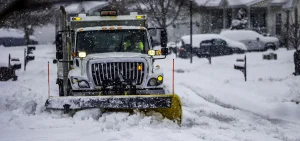2 Snowstorms in Iowa (Sara)
Snowstorms in Iowa
Types of winter storms
Winter storms effect the state of Iowa from October through April. Cold temperatures, snow, ice, high winds, dangerous wind chills and blizzard conditions can all occur, leading Iowans to wonder what type of winter will be in store for them that year. They hope for the best but must prepare for the worst.
The winter storms Iowans must prepare for include:
Snowstorms

Snowstorm involve a widespread snowfall accompanied by winds. The degree of these events varies from flurries to blizzards depending on the amount of snow falling and the rate of wind blow. Flurries are less of a concern when it comes to winter storms because snow falls for a shorter period, producing little accumulation, and causing less disruption. Communities are still able to go about their day, only with a slight increase of precaution. On the other hand, blizzards involve high speed winds with greater snowfall, leading to reduced visibility and more dangerous conditions. It is important to take precautions when these weather events occur to remain safe.10
Ice storms
Ice storms are storms of where a significant amount of freezing rain falls, causing a layer of ice to accumulate of surfaces. Typically, this weather events occurs when the air is cold, but not cold enough to make the water droplets fall as snow. Instead, the water droplets freeze on contact with anything below freezing temperatures, such as trees, power lines, and roads. The weight of ice can cause damage to nature and infrastructure and lead to hazardous road conditions.10
Dangerous Wind Chills
Wind chill is the sensation of cold produced by the wind for a given air temperature. It is measured on how cold the air feels on your skin based on how fast the wind removed heat from the body. Frostbite can start developing within 30 minutes of being outdoors when the wind chill drops below -20°F and hypothermia occurs once your core body temperature drops below 95°F, so it is important to remain indoors when the temperature reaches these extremes.6,10
Community Impacts
Winter storms have a profound and multifaceted impact on the state of Iowa, affecting residents at various levels, from daily life to economic stability. One of the most immediate and noticeable consequences is the disruption of transportation. Snow and ice on the roads lead to hazardous driving conditions, increasing the likelihood of accidents and injury. The risk of getting stranded or isolated also rises, particularly when snowplows cannot clear roads in time or when the storm intensifies beyond the capacity of local response teams. In such cases, it becomes crucial for individuals to have emergency supplies on hand, including items like flashlights, a first aid kit, a three-to-five-day food and water supply, and extra blankets for warmth.3
Beyond these immediate personal risks, winter storms also pose significant economic challenges. Lost productivity and business closures are common, as employees may be unable to commute safely or may need to stay home due to hazardous conditions. In addition, the costs associated with snow removal, road repairs, and recovery efforts can strain municipal budgets. The economic burden is also amplified by the direct costs related to infrastructure damage. Power outages, frozen water pipes, roof collapses, and structural damage from the weight of snow and ice can wreak homes, businesses, and public buildings. These damages often lead to higher insurance premiums or out-of-pocket expenses for residents or are sometimes covered by local governments. When the damage is widespread, federal assistance through the Federal Emergency Management Agency (FEMA) may be required to help restore services and repair infrastructure.9

Another significant concern is the impact on vulnerable populations within Iowa. The elderly and disabled individuals face challenges, as their limited mobility makes it difficult for them to seek shelter and warm during extreme conditions. These populations are at a heightened risk of injury or health complications when trapped indoors for extended periods. Rural and isolated communities also experience greater vulnerability, as they may have fewer resources, longer response times for emergency services, and longer periods of road closures before plows can clear the roads. Furthermore, low-income residents often lack proper heating or appropriate winter clothing, making it even more difficult for them to cope with the extreme cold during these storms.11
Considering these factors, it is crucial for Iowa to take a proactive approach to disaster preparedness, specifically tailored to its diverse population. Disaster response plans should incorporate strategies to support vulnerable groups, ensure timely access to emergency services, and prioritize infrastructure resilience. By understanding and addressing these risks, Iowa can better protect its residents during winter storms and mitigate the long-term economic and social effects.
Iowa’s Winter Storm Preparedness & Response
Iowa’s disaster preparedness and response efforts can be structured around the four main phases of the preparedness cycle: prevention/mitigation, preparedness/protection, response, and recovery. The goal is to enhance community readiness for emergencies and disasters through an ongoing, cyclical process, that starts well before an incident occurs and extends will after the initial response phase. Success depends on various key components, and the process is continually adjusted to adapt to the evolving needs and challenges of each situation.2
Prevention/Mitigation
The first step to preventing winter-related emergencies is the winterization of homes and vehicles. In Iowa, radio stations play a key role in educating residents about the importance of these preparations, emphasizing proactive measures to mitigate winter hazards.7
For homes, winterization involves several tasks: acquiring snow removal equipment such as shovels, snow blowers, or a reliable plow service, ensuring that the heating system is functioning efficiently and can withstand the coldest temperatures, and sealing any gaps or drafts to conserve warmth. Homeowners are encouraged to check insulation levels, inspect chimneys and vents, and have a backup heating source, such as a portable heater or generator, in case of power outages.5,7

When it comes to vehicles, ensuring they are ready for winter driving is crucial. This means equipping cars with winter tires, which provide better traction on snow and ice, and maintaining at least a half tank of gas. Drivers are also urged to keep emergency kits in their vehicles, including blankets, non-perishable food, water, and a flashlight, in case they become stranded.7
Public education plays a significant role in the success of these preventive measures. To increase awareness and encourage action, Iowa employs a variety of outreach channels, such as radio broadcasts, social media campaigns, and public service announcements. Social media, in particular, has become an effective tool for spreading winter storm tips, including advice on safe snow removal techniques, how to avoid slips and falls, and how to prepare a car for extreme conditions.
Additionally, schools in Iowa have started integrating disaster preparedness into their curriculum, teaching students about the potential risks of winter storms and the importance of planning ahead, these programs also include scheduled drills, such as evacuation exercises and practicing routes to emergency shelters, ensuring that both students and staff are familiar with the necessary steps to stay safe during severe weather events.
Through a combination of efforts, during this phase, Iowa works to ensure that its residents are well-equipped to handle the challenges of winter, reducing risk of injury, property damage, and other storm related impacts.
Preparedness/Protection
The largest phase of the emergency preparedness cycle focuses of getting Iowans and state systems ready for the upcoming winter storm. This crucial phase involved a comprehensive approach known as the Emergency Preparedness Operation—a proactive, coordinated effort to plan, organize, and prepare all necessary resources for an effective response before a storm strikes.
Several key agencies play pivotal roles in ensuring Iowa’s readiness for winter weather:
- Iowa Department of Homeland Security and Emergency Management (HSEMD): This agency takes the lead in disaster preparedness, response, and recovery efforts. It oversees the entire cycle and coordinates the actions of other agencies involved, enduring a unified and effective approach to crisis management, HSEMD’s responsibilities include developing and updating disaster response plans, managing resources, and providing support to local authorities during emergencies.2
- Iowa Department of Transportation (DOT): The DOT is responsible for snow and ice removal on the state’s roads, highways, and interstates. As winter storms approach, the department ramps up its operations, deploying snowplows, salting roads, and ensuring that transportation routes remain passable and safe for travel. Their efforts are key to maintaining mobility and reducing the risks of accidents caused by icy and snowy conditions.12
- Iowa State Patrol: The Iowa State Patrol, in collaboration with local law enforcement and first responders, is responsible for implementing search and rescue operations. They are frontline responders, providing immediate assistance to individuals who may be stranded, injured, or in need of care. Their role is vital in saving lives and ensuring public safety during hazardous weather conditions.
- County Emergency Management Agencies: At the local level, each county in Iowa has its own County Emergency Management Agency (CEMA), which develops specific disaster response plans tailored to the unique needs of their communities. These agencies work in tandem with state-level agencies, ensuring that every county is prepared for potential winter weather disruptions.
- Community Emergency Response Teams (CERT): Individuals can also volunteer in the state’s preparedness efforts by joining the Community Emergency Response Team. Members are trained to assist in local disaster response efforts, providing valuable support to first responders and helping their communities in times of crisis.

https://www.scottcountyiowa.gov/ema/alert-iowa - Alert Iowa: This statewide notification system plays a crucial role in keeping residents informed of upcoming weather events. Alert Iowa sends emergency alerts to residents, providing them with critical information about the storms timing, expected severity, and necessary precautions. These timely warnings allow Iowans to take the appropriate actions to protect themselves and their families before the storm hits.5
Winter weather alerts are essential for keeping Iowans informed about the upcoming weather conditions. These alerts provide clarity on the type and severity of the storm to offer guidance on when to take shelter or exercise caution. The key winter weather alerts include:
- Winter storm watch: Issues when conditions are favorable for the development for a winter storm, signaling residents should be prepared for possible severe weather.9
- Blizzard warning: Issued when sustained winds of 35 mph or more, along with snow or blowing snow, create near-zero visibility and dangerous travel conditions. This is a serious warning that conditions are life-threatening.9
- Winter weather advisory: A less severe alert issues when conditions could be hazardous, such as light snow, sleet, or freezing rain, but not expected to cause major disruptions.9
- Winter storm warning: Issued when a winter storm is expected soon or occurring, with significant accumulations of snow, sleet, or freezing rain expected to cause disruptions to travel, power, and general safety.9
- Frost/freeze warning: Issued when temperatures are expected to drop below freezing, putting plants, crops, and sensitive outdoor equipment at risk of frost damage.9
Through these coordinated efforts, Iowa aims to ensure that residents are well-prepared and informed, minimizing the impact of winter storms and maximizing safety across the state.
Response
The response phase of the emergency preparedness plan is crucial for managing the immediate actions taken during a winter storm in Iowa. It involves executing the pre-established strategies outlined in earlier stages to address the needs of residents, minimize disruption, and ensure safety. At the heart of this phase is the snow removal plan, which operates in three key phases: preparation, active snow event response, and post-storm cleanup.12
Phase 1: Pre-Storm Preparations
In the pre-storm phase, the Iowa Department of Transportation (DOT) undertakes proactive measures to prepare for the impending storm. This includes stockpiling materials such as salt, sand, and de-icing agents. Additionally, roads are pre-treated with brine to prevent ice accumulation and ensure roads are as resilient as possible against freezing temperatures and snow. These actions are vital for minimizing the impact of the storm and preventing the roads from becoming dangerously slippery.12
Phase 2: Snow Event Response

When the snowstorm begins, the response phase intensifies. The DOT ramps up operations to immediately clear major routes and highways as snow accumulates. Snowplows are dispatched to keep primary roads, highways, and interstates open, ensuring that the transportation networks remain as functional as possible under the severe weather conditions.12
Phase 3: Post-Storm Cleanup
Once the storm has passed, the post-storm cleanup begins. The focus shifts to clearing sidewalks, smaller streets, parking lots and other areas not covered during the initial storm response. Snow piles are removed from busy intersections and public spaces to prevent further hazards. De-icers are spread as needed to maintain safe driving conditions. Efforts in this phase continue until the environment returns to normal, with all roadways, walkways, and public spaces cleared and treated to ensure continued safety.12
An essential component of the response phase involves rescue operations, where both state and local agencies deploy specialized teams to assist stranded motorists and provide needed care. The Iowa State patrol, local police departments, and fire departments often work together to locate and rescue individuals trapped in their vehicles due to snowdrifts, accidents, or road blockages. These teams are equipped with the necessary tools to ensure safety and well-being of those in need of assistance, including medical aid when required.12
In severe weather conditions, emergency shelters become a lifeline for residents who are displaced or unable to return home due to dangerous travel conditions. Local governments coordinate the establishment of temporary shelters to provide refuge, such as the Linn County Overflow Shelter. These shelters offer a space for individuals and families, providing necessities like food, water, blankets, and medical supplies. Relief teams work around the clock to distribute resources to affected areas and ensure that vulnerable populations, such as the elderly or homeless, are properly cared for during the storm.8
Another important aspect of the response phase is the management of closures and operational adjustments. School districts play a significant role in this process by implementing delayed openings or early dismissals to accommodate the timing of the storm. School closures, often referred to as “snow days, are determined when snowfall reaches a level that is potentially unsafe for students and staff to travel. In some cases, extreme cold days may be declared, particularly when wind chill temperatures drop to dangerous levels, such as -20°F to -30°F, which poses a significant threat to outdoor exposure.
Businesses must also make decisions regarding operational adjustments. While they may not have standardized protocols lick schools, businesses often close or modify store hours depending on the severity of the storm and the safety of their employees and customers. Key industries, such as grocery stores and gas stations, may remain open for shorter hours to ensure essential goods are available, but other businesses may choose to close or work from home. Despite widespread closures, essential services such as hospitals, emergency medical services, and law enforcement must also continue functioning throughout the storm. To ensure these critical services remain operational, the snow removal plan is essential.5
Overall, the response phase of Iowa winter storm preparedness plan emphasizes coordination, preparation, and rapid action to minimize the impact on public safety and ensure that residents have the resources they need to stay safe during the storm. Through careful planning, timely intervention, and effective resource management, the state addresses the immediate challenges posed by severe winter weather each year and continues to get better with every storm.
Recovery
The final phase of Iowa’s emergency preparedness plan is recovery, which focuses on restoring normalcy and rebuilding communities following a major storm. This stage begins with comprehensive damage assessments, initiated by specialized damage survey teams. These teams are responsible for inspecting critical infrastructure, public facilities, and private homes to identify and document structural damage, safety hazards, and other storm-related impacts.2
A crucial part of the recovery process involved evaluating utility services. This includes electricity, gas, water, and communication systems. The Iowa Utilities Board, in coordination with local utility providers, assess the extent of service disruptions and oversees efforts to restore these essential services quickly.2

Once initial inspections are completed, Preliminary Damage Assessments are compiled. These reports estimate the overall cost of damages, which are used to determine eligibility for state pr federal disaster assistance. If the damages are extensive, the Iowa Department of Homeland Security and Emergency Management may request financial support from the Federal Emergency Management Agency (FEMA). This assistance may include Public Assistance grants to fund repairs or replacements for public infrastructure like roads, bridges, schools, and utilities.2
In addition to public infrastructure recovery, Iowa also provides individuals and families through its Individual Assistance Program. This program offers grants of up to $7,000 to eligible households for disaster-related needs such as personal property loss, temporary housing, medical expenses, and emergency home repairs.2
Overall, the recovery phase is a collaborative effort involving multiple state and federal agencies working together to ensure affected communities can rebuild and return to normal life as efficiently and equitably as possible.
Conclusion
Iowa’s Emergency Preparedness Plan is a comprehensive and coordinated framework designed to protect lives and property before, during, and after emergencies. Each of the four key phases play a vital role in reducing disaster impacts and ensuring a swift and effective return to normalcy.
Through proactive planning, interagency coordination, and community engagement, Iowa works to minimize risks and enhance resilience. From hazard identification and public education efforts to raped emergency response and long-term recovery initiatives, every phase is carefully designed to address the unique challenges faced by communities across the state. Supported by local, state, and federal partnerships, Iowa’s plan ensures a unified approach to disaster management that continues to evolve to fit the needs of the developing state. Ultimately, the goal is to protect the well-being of all Iowans and to strengthen the state’s capacity to withstand and recover from any emergency situation.
